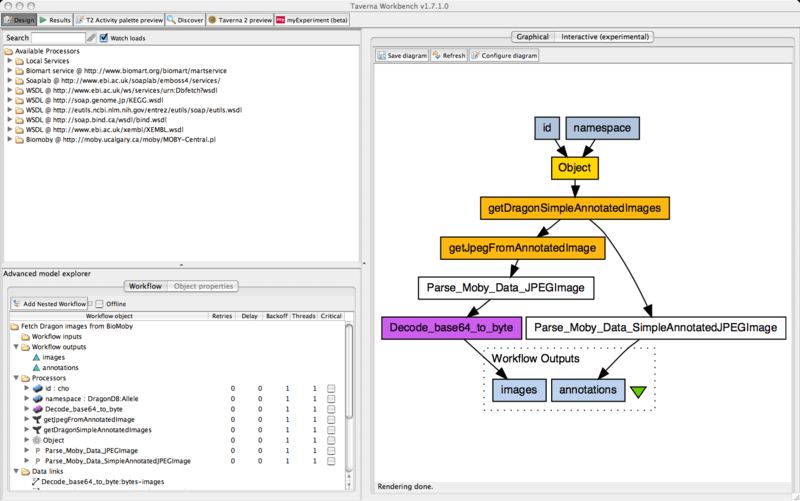The Taverna workbench is an open source software tool for designing and executing bioinformatics workflows created by the myGrid project.
Taverna allows users to integrate many different software components, including SOAP or REST Web services, such as those provided by the National Center for Biotechnology Information, the European Bioinformatics Institute, the DNA Databank of Japan (DDBJ), SoapLab, BioMOBY and EMBOSS. The set of available services is not finite and users can import new service descriptions into the Taverna Workbench.
The Taverna suite is written in Java and includes the Taverna Engine (used for enacting workflows) that powers both the Taverna Workbench (the desktop client application) and the Taverna Server (which allows remote execution of workflows). Taverna is also available as a Command Line Tool for a quick execution of workflows from a terminal.
Taverna is used by users in many domains, such as bioinformatics, cheminformatics, medicine, astronomy, social science and music.
Features include:
- Fully featured, extensible and scalable scientific Workflow Management System:
- Tabs for finding, designing and executing workflows.
- Fully graphical workflow design.
- Drag and drop workflow components.
- Comprehensive undo/redo.
- Built-in help facility.
- Annotations for describing workflows, services, inputs, outputs.
- Workflow validation and debugging.
- Execute and debug workflows:
- Execute workflows.
- Remember previously used workflow inputs.
- Save workflow input values used to a file.
- Load workflow input values from a file.
- Pipelining and streaming of data.
- Implicit iteration of service calls.
- Conditional and repeated calling of services.
- Customizable looping over a service.
- Failover and retry of service calling.
- Parallel execution and configurable number of concurrent threads.
- Improved error handling and reporting for debugging during run time.
- Monitor workflow execution.
- Pause/resume or cancel workflow execution.
- Manage previous runs and workflow results.
- View intermediate results and debug workflows at run time.
- Filter and save intermediate and final workflow results.
- Available as a desktop Workbench, from a command line or remotely as a Server.
- Access to local and remote resources and analysis tools, Web and grid services; 3500+ service s available on start up.
- Not restricted to predetermined services – rapid incorporation of new services without coding.
- Extensible service plug-in architecture for adding new service type.
- Excel and csv spreadsheet support.
- Invoke general SOAP/WSDL or REST Web services, and more specific SADI, BioMart, BioMoby and SoapLab Web services.
- Invoke R statistical services.
- Invoke local Java code.
- Invoke external tools on remote machines (via ssh), D.
- Do XPath and other text manipulation.
- Import a spreadsheet and include sub-workflows.
- Search for services described in BioCatalogue to include within workflows.
- Search for workflows on myExperiment. You can download, modify and run the workflows discovered on myExperiment from within the Taverna Workbench.
- Plugins to extend functionality.
Website: taverna.incubator.apache.org
Support: Documentation
Developer: myGrid
License: GNU LGPL 2.1

Taverna is written in Java. Learn Java with our recommended free books and free tutorials.
Return to Bioinformatics Tools
| Popular series | |
|---|---|
| The largest compilation of the best free and open source software in the universe. Each article is supplied with a legendary ratings chart helping you to make informed decisions. | |
| Hundreds of in-depth reviews offering our unbiased and expert opinion on software. We offer helpful and impartial information. | |
| The Big List of Active Linux Distros is a large compilation of actively developed Linux distributions. | |
| Replace proprietary software with open source alternatives: Google, Microsoft, Apple, Adobe, IBM, Autodesk, Oracle, Atlassian, Corel, Cisco, Intuit, and SAS. | |
| Awesome Free Linux Games Tools showcases a series of tools that making gaming on Linux a more pleasurable experience. This is a new series. | |
| Machine Learning explores practical applications of machine learning and deep learning from a Linux perspective. We've written reviews of more than 40 self-hosted apps. All are free and open source. | |
| New to Linux? Read our Linux for Starters series. We start right at the basics and teach you everything you need to know to get started with Linux. | |
| Alternatives to popular CLI tools showcases essential tools that are modern replacements for core Linux utilities. | |
| Essential Linux system tools focuses on small, indispensable utilities, useful for system administrators as well as regular users. | |
| Linux utilities to maximise your productivity. Small, indispensable tools, useful for anyone running a Linux machine. | |
| Surveys popular streaming services from a Linux perspective: Amazon Music Unlimited, Myuzi, Spotify, Deezer, Tidal. | |
| Saving Money with Linux looks at how you can reduce your energy bills running Linux. | |
| Home computers became commonplace in the 1980s. Emulate home computers including the Commodore 64, Amiga, Atari ST, ZX81, Amstrad CPC, and ZX Spectrum. | |
| Now and Then examines how promising open source software fared over the years. It can be a bumpy ride. | |
| Linux at Home looks at a range of home activities where Linux can play its part, making the most of our time at home, keeping active and engaged. | |
| Linux Candy reveals the lighter side of Linux. Have some fun and escape from the daily drudgery. | |
| Getting Started with Docker helps you master Docker, a set of platform as a service products that delivers software in packages called containers. | |
| Best Free Android Apps. We showcase free Android apps that are definitely worth downloading. There's a strict eligibility criteria for inclusion in this series. | |
| These best free books accelerate your learning of every programming language. Learn a new language today! | |
| These free tutorials offer the perfect tonic to our free programming books series. | |
| Linux Around The World showcases usergroups that are relevant to Linux enthusiasts. Great ways to meet up with fellow enthusiasts. | |
| Stars and Stripes is an occasional series looking at the impact of Linux in the USA. | |
